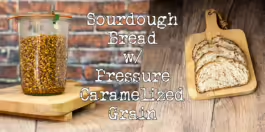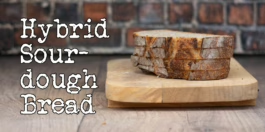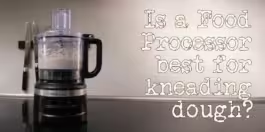I love great sourdough bread, but sometimes you need soft white bread for a delicious sandwich. This is a combination of the two of them. A soft white bread, with a delicious caramelized crust and a very soft and slightly tangy interior. The best of both worlds. This is my sourdough sandwich bread recipe.
Sandwich bread is made specifically for the preparation of sandwiches. They are easily sliced and usually have a light crumb.
If you are just here for the recipe, you can press the button underneath to be automagically transported to the recipe:
Jump to Recipe Jump to VideoNew and improved recipe!
This recipe was originally released in January 2020, but has been updated in October 2022 to a much simpler recipe based on all the experiments that I’ve made on my YouTube channel.
The history of sandwich bread
Sandwich bread, or pain de mie, or sometimes Pullman loaf (named for the tin that it’s baked in) came to prominence in the early 1900s.
In 1928 the first automatic bread slicing machine became available, and with thinner and more uniform slices bread consumption began to rise.

In 1943 a short-lived ban on sliced bread in the United States, as a wartime conservation measure. It resulted in a public outcry and only three months after the ban took effect it was abolished again.
In the second half of the 20th century, sandwich bread became synonymous with really unhealthy bread with nothing good for you in it. That pretty much still holds true if you buy it in the supermarket.
If you make it yourself that is a whole different story.
The formula in this sourdough sandwich bread recipe
Vitals
| Total weight | 1830 grams |
| Pre-fermented flour | 7.7% |
| Hydration | 69.2% |
| Yield | 2 x 915 grams loaves |
Dough
The bread is made with 100% all-purpose flour. Which should be your regular 10-ish percent protein wheat flour. I’d opt for the organic kind. If you want a little bit of a sturdier, but more flavorful bread, you can substitute with up to 20% whole-grain flour.
If you want 100% whole grain sandwich bread, you should try my spelt sandwich bread. It is so good!
This gives you a softer bread, both crust, and crumb, but enough gluten development to make good bread.
It has a little above 10% butter, which gives the bread a wonderful buttery, nutty aroma, and also helps soften the crumb further.
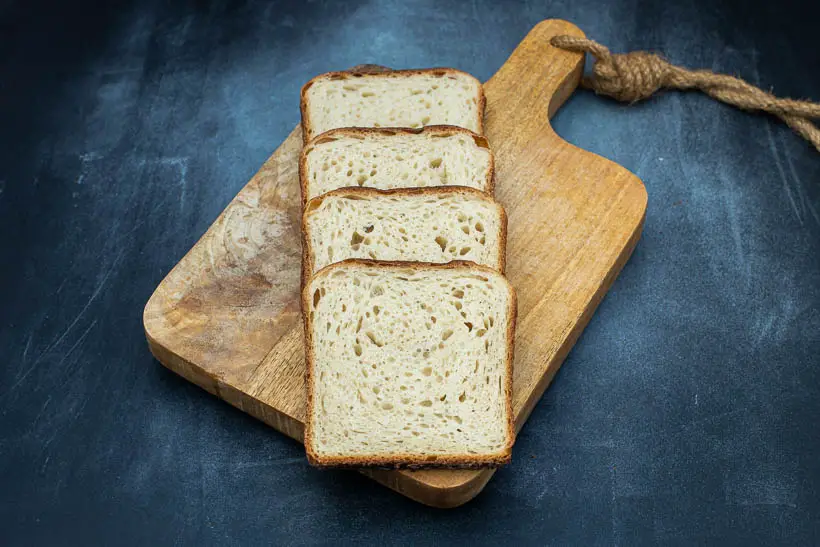
A little bit of sugar has been added to give a sweeter taste, but also temper the tang in the starter. If you have a particularly acidic starter or you like your bread on the sweeter side, you can double this amount.
Part of the fluid in the has been replaced by milk. The softer the crumb you want, the higher percentage of fat in the milk you can use. If you want to be extravagant you can go for half whipping cream, and half whole milk.
The amount of starter is just shy of 17%, which will give you a long fermentation, even if done warm.
| Weight | Ingredient | Baker's Percentage |
|---|---|---|
| 900g | all-purpose flour | 100% |
| 100g | butter, salted | 11.1% |
| 60g | cane sugar | 6.7% |
| 200g | whole milk (3.5%) | 22.2% |
| 400g | water | 44.4% |
| 20g | salt | 2.2% |
| 150g | starter (100% hydration) | 16.7% |
If you want to change the formula for this bread, you can do it in my bread calculator here.
If you want to use a different pan size, you can calculate the dough weight needed here:
The conclusion of this sourdough sandwich bread recipe
While this is a bread made with a sourdough starter, it doesn’t seem like that at all.
The crust is really soft but very brown and caramelized with the most delicious buttery smell coming from it.
The crumb is soft and moist, with the slightest hint of a tang from the sourdough starter. Enough to give the bread a wonderful character.
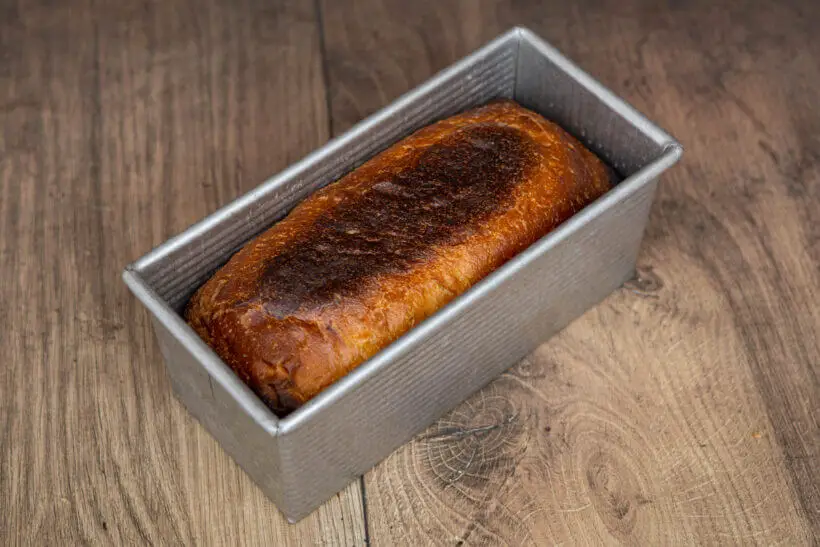
The bread has enough taste to be able to stand on its own if you want that, but not so much that it will overpower the ingredients you put on it.
Because of the relatively high hydration compared to other sandwich loaves, it stays wonderful and moist (if kept in a ziplock bag) for up to 5 days.
It’s a total no-brainer. This should be your go-to sandwich bread.
Please share this sourdough sandwich bread recipe on social media
This is my recipe for sourdough sandwich bread. I hope you will try to make it because it’s absolutely delicious.
If you bake it and post it on Instagram, please tag me as @foodgeek.dk, so I can see it. That would make me very happy.
Ad links! The links for equipment and ingredients in this recipe are affiliate links, which means I will receive a commission if you purchase the product.
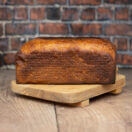
Sourdough Sandwich Bread
Ingredients
Dough
- 900 g all-purpose flour
- 60 g cane sugar
- 20 g salt
- 150 g sourdough starter fed and grown to its peak
- 100 g butter melted
- 400 g water
- 200 g milk
Instructions
Mix the dough and bulk fermentation
- Add bread flour, cane sugar, and salt to a medium bowl. Mix it up.
- Add the melted butter to the water and stir it, then add the milk. Add the starter to the flour and then the liquids.
- Mix the dough using your hands. Then add the dough to a medium cambro container, cover it and mark where it will have grown 25%.
- Put the dough somewhere warm and let it grow 25%. Don't go by time; go by growth. In my proofer set to 30°C/86°F, it took about 3 hours.
Divide and preshape
- Then grab the dough and put it on your unfloured kitchen counter.
- Divide it into two equally sized pieces and shape each piece into a ball using your bench scraper.
Final shape
- Spray two bread tins with non-stick spray. Lightly flour your counter and flip a dough ball onto the flour.
- Degas the dough and tease it out into a rectangle.
- Pull the bottom of the dough out and fold it up about a third. Then repeat from the left and the right side.
- Roll the dough up tightly, so the seam ends underneath the loaf. Move the loaf to the tin and repeat with the other one.
Final rise
- Then let the dough ferment until it grows about 50-75%. In an appropirately sized Pullman, you are looking for it to be about 1 inch/2.5 cm from the top.
- When you see the dough is almost ready, heat your oven to 220°C/425°F.
- If you bake the bread without a lid, you should glaze the bread with an egg yolk mixed with one tablespoon of milk.
Bake the loaves
- Add the bread to the oven and bake for about 35 minutes. Then turn down the temperature to 190°C/375°F. If baking covered you should remove the lid.
- Bake for another 10-15 minutes until the bread registers 99°C/210°F on a probe thermometer. Then take it out of the oven and let it cool completely on a wire rack.




